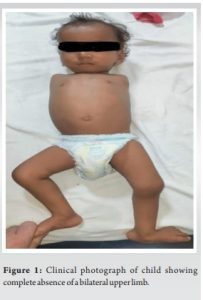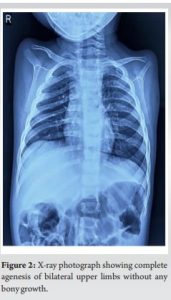The purpose of this case report is to enlighten the causes of Amelia and its presentations in current times.
Dr. Syed Faisal Afaque, Department of Paediatric Orthopaedics, King George’s Medical University, Lucknow, Uttar Pradesh, India. E-mail: syedfaisalafaque@gmail.com
Introduction: Congenital upper limb amelia is one of the extremely rare conditions. It is defined as a complete absence of upper limbs. It may present as isolated or with other associated anomalies.
Case Report: We present a case of a 2-year-old male child with congenital complete absence of bilateral upper limb. This male child was born after four female children. With the advancement in modern-era prenatal diagnostic facilities and a better understanding of fetal-maternal drug pharmacology, such cases are rare entity.
Conclusion: Amelia is a very rare and challenging situation for clinicians. Regular prenatal checkup and knowledge of maternal and fetal drug interactions during pregnancy are key factors for prevention.
Keywords: Amelia, congenital limb deficiency, teratogenic drugs.
Amelia is defined as a complete absence of a limb and is a rare congenital anomaly with incidence ranging from 0.053 to 0.095 in 10,000 live births [1-3]. It mostly affects the upper limb. Proximal part of the limb is absent with the distal extremity attached to the trunk. Sometimes, the limbs can be missing completely. It may also be associated with other malformations. The exact pathogenesis is still unclear, but mostly, it is believed that it occurs as a sporadic event [4]. It is found by some researchers that it may be related to some teratogens such as thalidomide, alcohol, maternal diabetes, and vascular compromise by amniotic bands [5-7].
We present a case of a 2-year-old male child who came to the outpatient department with the absence of both upper limbs. On examination, no dysmorphic features were noted aside from bilateral absent upper limbs from the shoulder (Fig. 1 and 2).


Amelia is a rare congenital entity. The incidence of upper limb amelia is approximately 7/1,000,000 live births [3]. Children with amelia with other associated malformations usually have a bad prognosis and die within 1 year. Amelia has been associated with early-onset scoliosis. Powers et al. [8] performed a retrospective study to determine the incidence of scoliosis in patients with upper limb skeletal abnormalities and concluded that patients with amelia had a higher incidence of idiopathic scoliosis (unilateral amelia = 50% incidence/bilateral = 100%) [8]. Froster et al. [9] suggested that the combination of brachial amelia, forebrain defect, and facial cleft may represent a new syndrome. Urinary tract abnormalities are known to be associated with limb defects [10]. Several causes have been proposed such as consumption of alcohol and teratogenic drugs such as thalidomide, vascular compromise by amniotic bands, maternal diabetes, and autosomal recessive mutations [5-7]. This case report describes the case of amelia in a couple with four healthy daughters without any obvious historical event. Although the exact cause is not known in this patient, one big possibility could be the effect of taking unknown unsafe drugs during pregnancy in the desire to have a male child, which is prevalent in developing countries. People consume toxic and harmful drugs in the hope of having a male child. One more important point is, still in developing countries, osteopaths are doing unethical practices and due to lack of education and knowledge, especially in rural areas, people consume unknown and unsafe drugs which lead to such conditions.
Amelia is one of the very rare and challenging conditions affecting limb development. Other associated anomalies in these patients should be identified. Regular prenatal checkup and knowledge of maternal and fetal drug interactions during pregnancy are key factors for prevention.
Bilateral upper limb amelia is very rare congenital anomaly which may be associated with other anomalies. Several factors are involved but to highlight one important factor is taking some unsafe drugs such as thalidomide during pregnancy in desire of having a male child. This practise is still prevalent in developing countries wherein such teratogenic drugs are prescribed by osteopaths and due to lack of knowledge, it is consumed during pregnancy which leads to congenital anomalies
References
- 1.Bod M, Czeizel A, Lenz W. Incidence at birth of different types of limb reduction abnormalities in Hungary 1975-1977. Hum Genet 1983;65:27-33. [Google Scholar]
- 2.Källén B, Rahmani TM, Winberg J. Infants with congenital limb reduction registered in the Swedish register of congenital malformations. Teratology 1984;29:73-85. [Google Scholar]
- 3.Frosta-Iskenius UG, Baird PA. Amelia-incidence and associated defects in a large population. Teratology 1990;41:23-31. [Google Scholar]
- 4.Lenz W. Genetics and limb deficiencies. Clin Orthop Relat Res 1980;148:9-17. [Google Scholar]
- 5.Smithells RW, Newman CG. Recognition of thalidomide defects. J Med Genet 1992;29:716-23. [Google Scholar]
- 6.Pauli RM, Feldman PF. Major limb malformations following intrauterine exposure to ethanol: Two additional cases and literature review. Teratology 1986;33:273-80. [Google Scholar]
- 7.Bruyere HJ, Viseskul C, Opitz JM, Langer LO, Ishikawa S, Gilbert EF. A fetus with upper limb Amelia, “caudal regression” and Dandy-Walker defect with an insulin- dependent diabetic mother. Eur J Pediatr 1980;134:139-43. [Google Scholar]
- 8.Powers TA, Haher TR, Devlin VJ, Spencer D, Millar EA. Abnormalities of the spine in relation to congenital upper limb deficiencies. J Pediatr Orthop 1983;3:471-4. [Google Scholar]
- 9.Froster UG, Briner J, Zimmermann R, Huch R, Huch A. Bilateral brachial Amelia, facial clefts, omphalocele: A recurrent fetal malformation pattern coming into focus. Clin Dysmorph 1996;5:171-4. [Google Scholar]
- 10.Curran AS, Curran JP. Associated acral and renal malformations: A new syndrome? Pediatrics 1972;49:716-25. [Google Scholar]








